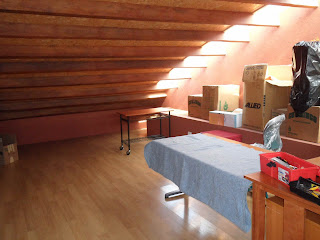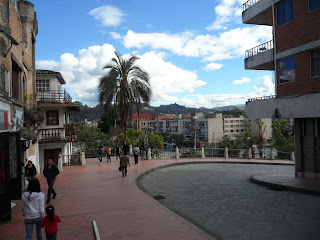Oh my gosh! I did not anticipate how challenging it would be to avoid wheat here. Some people have what is called
celiac disease, meaning they cannot eat wheat, barley or rye, which all have gluten (more on that below). Avoiding gluten in the US has become much easier in the past 5 years because a lot of products have been showing up as well as specialty stores where there are many great products without gluten .Even Betty Crocker and Rice Krispies offer a gluten free choices.
Fresh fruits and vegetables are fine,as are meat, chicken, dairy, eggs - just not wheat, rye and barley are the trouble-makers for people with celiac disease. This photo shows pitajaya, a tropical fruit Len and I have really fallen for. It has a taste similar to kiwi, has many health benefits and is terrific in a smoothie.
In the US, one can buy pasta made of quinoa, rice or corn, cake mixes without any wheat in them, sauces and condiments that are wheat free, pizza crust and many other things. At an upscale grocery store in Portland, I found products from Peru that were delicious. I assumed they would be easily available in Ecuador. Blue corn flour, sweet potato flour, a couple of grains high in protein but I can no longer recall the names.
I knew the ready-made wheat-free products would not be available here but I assumed products like the grains and flours from Peru would be easily available in Ecuador. Coconut flour, almond flour and date palm sugar are all good products I figured would be here. After all, palms and coconuts are growing all over the place at lower elevations in Ecuador. Fresh coconut is offered by street vendors every day.
Wrong! Ecuador (for better and for worse) tries not to import products, encouraging people to buy and use Ecuadorian products. So even blue corn flour from Peru is nowhere to be found. I'm not sure why there is no coconut flour or palm sugar but...I have not been able to find any.
There are many many tiendas here (small shops) so it is possible I have missed where these products are sold but...so far I have not had success in finding some basics I need.
I adapted a recipe for coconut shrimp, making the batter out of "approved" quinoa flour. The green stuff is chard picked that morning and sauteed with garlic and a little olive oil. That is fresh pineapple and the strawberries add color. It was delicious. Ecuador has an enviable supply of fresh fish from the Pacific Ocean.
x
I make most of the food we eat. I enjoy cooking and baking. I had found ways to work around the gluten free challenges, making pizza crust, salad dressings, soups, whole grain bread and, cupcakes that were all delicious. Now, I am a little too challenged. Striking out at finding flours and grains that I can have. I have found no brown rice flour. No teff flour (the oldest and smallest grain in the world with a nice nutty flavor and high in protein). No sorghum flour. I could go on but you get the picture.
These are some of the flours I have found that are gluten free.
The other day I found banana flour. Yup, somehow it is made from banana and it has no gluten. I mixed it about half and half with some sorghum flour I had brought with me and made cookies. They were delicious! OK, so we have a start. I made a fresh banana cake which was delicious and gf (gluten free). And corn is fine so many ways to make corn flour into delicious things.
Gluten free chocolate chip cookie dough - makes cookies that do not seem any different from the regular recipe. I used about 1/3 banana flour. There was a very bare hint of banana flavor when the cookies were cold but not at other times.
Ecuador has wonderful pan (bread) in many neighborhood bakeries - there is nearly one on every block! But I have not found any that are making gluten free products. I don't mean to whine but...am I the only one in Ecuador who is trying to be gluten free? That is not possible, is it?
Why is it important to be gluten free if you have celiac disease? gluten is a protein found in wheat, barley, rye, spelt, kamut, and oats. My non official explanation: gluten causes inflammation in some people with sensitivity which damages the small intestine and also causes pain in people with fibromyalgia and possibly arthritis. Joints, muscles and connective tissue seem to be impacted by the inflammation. Many people report digestive upset, bloating and other unpleasant intestinal effects if they eat gluten. Some people are
really sensitive and can be sick for days from one small exposure or a slight contamination from wheat. Others just find that they feel better and have more energy if they do not consume gluten loaded products.
This is baked chicken with fresh salsa made from tomatoes, avocado, papaya, pineapple, lime, garlic and red onion. Rica and salad round out the meal which is gluten free and made from scratch at home.
It is really fun to go out for lunch in Cuenca. Many restaurants have a special almuerzo which costs around $2.50/person. It includes usually a delicious soup, rice or potatoes, popcorn (to put in the soup), a main entree like fish, chicken, beef, a fresh juice and a tiny dessert. The problem is for me that most places are unaware of gluten problems so wheat flour is used to bread meats, to thicken soups, and other ways they would not think of to mention if asked "is there any wheat flour or barley in this?"
I have tried a couple of vegetarian restaurants, hoping they would not use wheat or barley but there also wheat is used as a thickener in soups and added to so many foods. I found barley in one soup after the owner told me there was no gluten in the soup.
So mostly I do not go out for meals. Better to feel good than have a social experience that causes problems.
My Espanol is not good at all, I am learning Spanish but slowly.
I carry this note with me at all times:
"Soy alergica. (I am alergic)Sin trigo (no wheat), sin cebada (no barley), sin centeno (no rye).
Libre de gluten (gluten free)"
This smoothie has papaya (orange colored fruit), cherimoya (which lends a cloud like quality to the drink), pitajaya, an orange and coconut-pineapple yogurt. All gluten free.
I need a Gluten Free Users Group!! Please let me know if you are eating free of wheat/gluten here in Cuenca, EC.Or if you know of a market that sells coconut flour, palm sugar, other gluten free flours.
Tonight I am blanching almonds and will grind them to make my own flour. Yesterday, I found brown rice (arroz integral) and ground some to make brown rice flour, a great staple for cooking/baking gf. It was not as fine as I'd like but it was a great start.
If you think you may react to wheat or gluten, there is a simple blood test that can be done.
Here are some helpful sites:
http://www.celiaccentral.org/News/NFCA-Blogs/Recipe-of-the-Week
http://gflinks.com/ many sites, resources and books are listed here
glutenfreegoddess.blogspot.com/
You +1'd this publicly.
Undo
http://www.mayoclinic.com/health/celiac-disease/DS00319/
Scott Adams put up
Celiac.com in 1995. It was the first important site on celiac disease. And Scott has been relentlessly expanding it ever since. This is where most people start.
---------------------------------------------
Almond flour is a healthy choice but I've not been able to find any here. I have a new, unused coffee grinder for grinding my own flours. I have a pound of almonds. They need to be blanched (taking the brown husks off) and dried before I can grind them into flour.
How Do You Blanch Almonds? I found these directions online.
Difficulty: Easy
Time Required: 5 minutes
Here's How:
- Place almonds in a bowl.
- Pour boiling water to barely cover almonds.
- Let the almonds sit for 1 minute and no longer.
- Drain, rinse under cold water, and drain again.
- Pat dry and slip the skins off.
Tips:
- Don't let almonds sit in hot water too long or they will lose their crispness.
- 1 pound of almonds in the shell will yield about 1-1/2 cups shelled.
- 1 pound shelled = 3 cups whole or 4 cups slivered.
What You Need: almonds!






















































